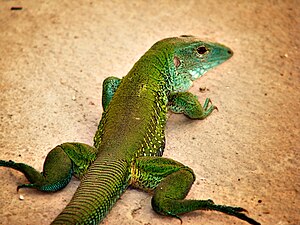Teiinae
| Teiinae | ||||||||||||
|---|---|---|---|---|---|---|---|---|---|---|---|---|

Green ameive ( Ameiva ameiva ) |
||||||||||||
| Systematics | ||||||||||||
|
||||||||||||
| Scientific name | ||||||||||||
| Teiinae | ||||||||||||
| Presch , 1970 |
The Teiinae are a subfamily of the rail lizards (Teiidae) occurring from southern North America to central South America (northern Argentina ).
features
They are generally small to medium-sized lizards with an elongated body, long whip-like tail, and long hind legs. Their head-torso length ranges from 4.5 to 20 cm. One of the characteristic features of the subfamily is that the anterior inner (anteromedial) edge of the supratemporal window is formed by the postfrontal and / or postorbital instead of the parietal. Other peculiarities of the skull are a medially extended quadratum ( square leg ) that is connected to the wing bone ( pterygoid ) via a sliding joint, as well as a nasal apophysis on the maxillary. The section of the mandible behind the temporomandibular joint ( retroarticular process ) bears a dorsal pit or furrow. Femoral and abdominal pores form a continuous row. The number of presacral vertebrae (vertebrae in front of the sacrum ) is 25, the abdominal scales are arranged in 6 to 20 rows. The diploid genome comprises 2n = 46 to 56 chromosomes .
Way of life
Teiinae are found in a wide range of habitats, from the Amazon rainforest to dry grasslands, and are typically active at relatively high temperatures (up to 40 ° C). The species of the genus Aspidoscelis living in North America only become active at temperatures above 24 ° C and remain in their earthworks at lower temperatures. Almost all species are active predators and use their eyes and smell to track down their food, which consists mainly of various arthropods . Termites play a large part in their diet in many species . The prey animals are often dug up. Insects that can defend themselves with the help of corrosive and malodorous liquids, such as many beetles and almost all ants, are avoided. Three species, Cnemidophorus arubensis , Cnemidophorus murinus and Dicrodon guttulatum , are herbivores. All Teiinae reproduce oviparously , that is, they lay eggs. The clutch size depends on the body size, Cnemidophorus arubensis only lays a single, very large egg. In the genera Aspidoscelis, Cnemidophorus, Kentropyx and Teius there are unisexual species that reproduce through parthenogenesis , in Aspidoscelis they make up about a third of the over 40 species.
Systematics
The Teiinae include 13 genera and over 120 species:
-
Ameiven ( Ameiva Meyer, 1795)
- Green ameive ( Ameiva ameiva )
- Central American Ameive ( Ameiva festiva )
- † Guadeloupe-Ameive ( Ameiva cineracea Barbour & Noble, 1915)
- Ameivula Harvey, Ugueto & Gutberlet, 2012
- Aspidoscelis Fitzinger, 1843
- Aurivela Harvey, Ugueto & Gutberlet, 2012
- Cnemidophorus Wagler, 1830
- Contomastix Harvey, Ugueto & Gutberlet, 2012
- Dicrodon Duméril & Bibron, 1839
- Glaucomastix Goicoechea, Frost, De la Riva, Pellegrino, Sites, Rodrigues & Padial, 2016
- Holcosus Cope, 1862
- Kentropyx Spix, 1825
- Medopheos Harvey, Ugueto & Gutberlet, 2012
- Pholidoscelis Fitzinger, 1843
- Teius Merrem, 1820 type genus
literature
- Laurie J. Vitt, Janalee P. Caldwell: Herpetology: An Introductory Biology of Amphibians and Reptiles. Elsevier Ltd, Oxford 2013, ISBN 978-0123869197 .
- Michael B. Harvey, Gabriel N. Ugueto & Ronald L. Gutberlet, Jr .: Review of teiid morphology with a revised taxonomy and phylogeny of the Teiidae (Lepidosauria: Squamata) (= Zootaxa . Vol. 3459). Magnolia Press, Auckland 2012, ISBN 978-1-86977-987-0 , pp. 1-156 ( online ).

